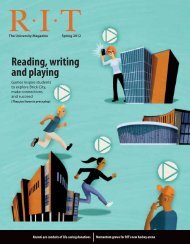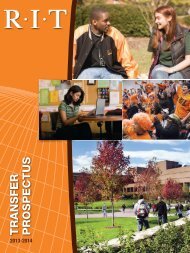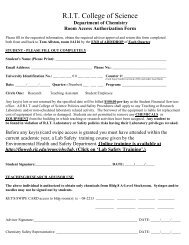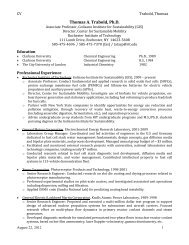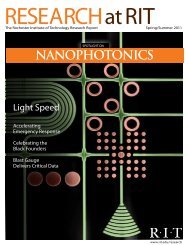Fall / Winter 2012 - Rochester Institute of Technology
Fall / Winter 2012 - Rochester Institute of Technology
Fall / Winter 2012 - Rochester Institute of Technology
Create successful ePaper yourself
Turn your PDF publications into a flip-book with our unique Google optimized e-Paper software.
Focus Area | Unlocking the Mysteries <strong>of</strong> the Deaf Brain<br />
Muscle Movement<br />
Sensory<br />
Information<br />
Executive Skills<br />
Motor Planning<br />
Movement<br />
Sensory<br />
Perceptions<br />
Language Understanding<br />
Planning<br />
Organization<br />
Writing<br />
Language<br />
Production<br />
Hearing<br />
Vision<br />
Reasoning<br />
Perceptions<br />
Executive function is that portion <strong>of</strong> the brain that controls central<br />
cognitive functions, including behavior and memory. Hauser seeks<br />
to examine how executive function works differently in deaf brains.<br />
Assessing Sign Language Pr<strong>of</strong>iciency: Hauser’s team created one <strong>of</strong><br />
the first standardized tests to measure pr<strong>of</strong>iciency in ASL. The test<br />
utilizes standard linguistic techniques used in spoken language<br />
assessments to rate fluency among ASL users.<br />
ages 8 to 16 from four different countries<br />
(with five languages) on letter recognition,<br />
word recognition, and how the<br />
reader processed semantics and sentence<br />
processing. Participants included deaf<br />
children <strong>of</strong> deaf parents, deaf children<br />
with hearing parents, hearing children,<br />
and hearing children with dyslexia.<br />
The preliminary findings appear to<br />
suggest that early sign language acquisition<br />
and deaf parents’ indigenous<br />
knowledge on how to raise deaf children<br />
prepare students to become successful<br />
readers regardless <strong>of</strong> the language,<br />
written orthography type, or region.<br />
Deaf children raised by deaf parents are<br />
able to achieve the same basic reading<br />
skills as hearing individuals early in life,<br />
suggesting that deafness per se does not<br />
cause reading challenges but what does<br />
have an effect is being raised in improvised<br />
visual language environments<br />
that do not foster visual learning.<br />
Hauser’s neuroimaging research<br />
also suggests that skilled deaf readers<br />
use different parts <strong>of</strong> their brains for<br />
processing reading.<br />
“Traditional methods for teaching<br />
reading and assessing comprehension<br />
are based on how hearing people learn<br />
and do not generally take into account<br />
the visual needs <strong>of</strong> deaf learners,”<br />
Hauser says. “Our research shows that<br />
deaf students do not necessarily learn<br />
to read more slowly than hearing<br />
students—just differently.”<br />
Understanding Executive Function<br />
“Attention control, emotional control,<br />
impulse control, memory, organizing<br />
your thoughts, planning your thoughts—<br />
these are all components <strong>of</strong> executive<br />
function that continue to develop<br />
in the brain until early adulthood,”<br />
Hauser says. “And language appears<br />
to be a necessary component <strong>of</strong><br />
executive function development.<br />
But for the majority <strong>of</strong> deaf people<br />
growing up in hearing families,<br />
language development is delayed.”<br />
Hauser argues that inefficient<br />
executive function development can<br />
have a negative impact on learning<br />
and academic achievement. His team<br />
is conducting a series <strong>of</strong> experiments,<br />
using both deaf and hearing participants,<br />
to investigate the impact <strong>of</strong> language<br />
learning on executive development.<br />
“The problem we encountered when<br />
beginning this research was that there<br />
are no standardized tests available to<br />
measure individuals’ sign language<br />
fluency,” he continues.<br />
Research at RIT<br />
11





